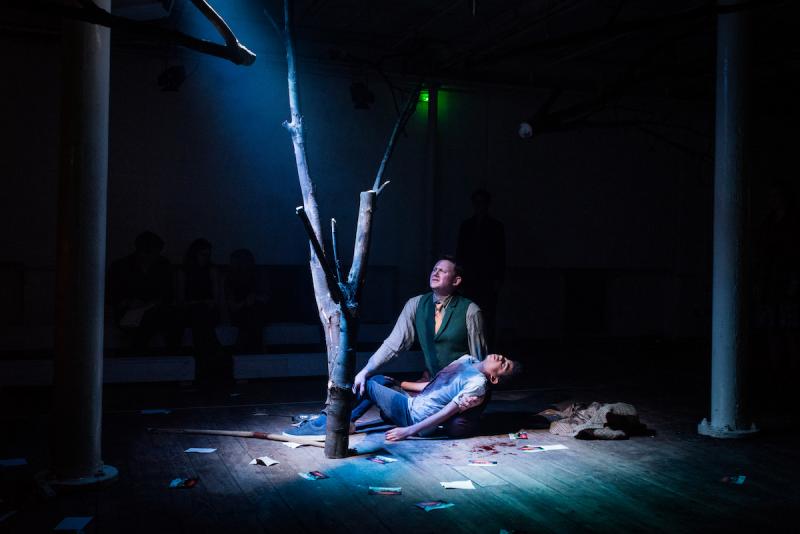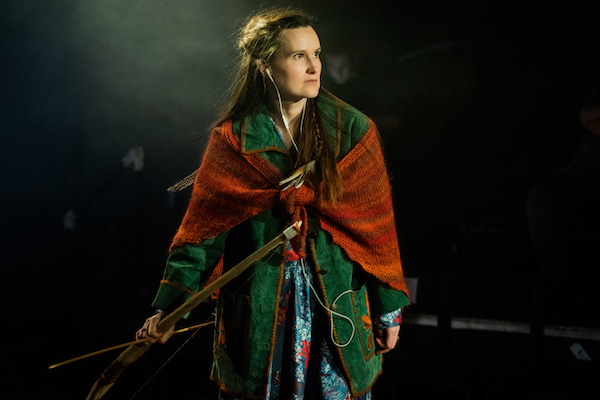Robin Hood, The Opera Story, CLF Café review - folk hero re-imagined as Tory villain | reviews, news & interviews
Robin Hood, The Opera Story, CLF Café review - folk hero re-imagined as Tory villain
Robin Hood, The Opera Story, CLF Café review - folk hero re-imagined as Tory villain
The plot is over-stuffed, but this new opera has some riveting moments

What’s the one thing everyone knows about Robin Hood? That he steals from the rich and gives to the poor. So it was quite a brave decision to re-cast Robin as a rapacious Tory shires MP, doing his best to stop the poor becoming rich. At least, I think that was what happened: in much of the story is opaque, even having read the synopsis carefully.
The Opera Story is a young company in only its third season, but already onto its third new piece. It doesn’t lack ambition: the cast is six-strong, there is a 10-piece band, and with the production shifting downstairs to a different room for the second half, two whole sets and lighting rigs. The venue, the CLF Café, is a vibrant community space in Peckham in east London, where the opera takes place over two floors.
Following the success of their first two fairytale-based operas, The Opera Story turned to the greatest of all English folk-heroes, in a modernised version with music by Dani Howard and libretto by Zoë Palmer and Rebecca Hurst. (The all-female creative team extends to director Polly Graham, designer April Dalton, lighting designer Claire Childs and the excellent conductor Berrak Dyer.)
The updating of the story involves Robin Hood (Nicholas Merryweather) running a laddish London drinking-den, leading a secretive male hunting group “The Merry Men” all while being MP and Lord of the Greenwood, a forest under threat from an urban development. This development, Boom Town, is the brainchild of Joanna (Lorna Anderson), suited and sometimes moustachioed, whose son has gone missing. Robin Hood is also haunted by the recollection of a boy he accidentally killed while out hunting. No surprises for guessing that these two children are one and the same, and that the denouement is this discovery.
It has to be said the plot is as over-stuffed as the taxidermy in Robin’s club, with contemporary issues of housing development, male privilege, corrupt politicians and more besides squeezed into just 85 minutes of action. It needed to do less, as the first half in particular felt a bit bewildering. But the libretto was very singable, in particular the well-worked dramatic moment that ended the first half, with Joanna shrieking “Where is my son?” Also effective was her meditation at the beginning of the second half: “No golden sun, no stars, no moon. No path, no river, no way home. My son is gone”, beautifully sung by Lorna Anderson and magically scored for string harmonics and bowed vibraphone. The consequence of the first half being so plot-heavy is that the music is constantly on the move, with little time for reflection and that old opera staple, aria. Although the music propels things along, the relief is palpable when Robin’s sister and eco-campaigner Marian (Sîan Cameron, pictured above by Robert Workman) enters for a shimmering set-piece “It’s that greening time of year”.
The consequence of the first half being so plot-heavy is that the music is constantly on the move, with little time for reflection and that old opera staple, aria. Although the music propels things along, the relief is palpable when Robin’s sister and eco-campaigner Marian (Sîan Cameron, pictured above by Robert Workman) enters for a shimmering set-piece “It’s that greening time of year”.
By contrast, the second half consists almost entirely of reflection, as the characters’ actions lead to crisis, with Robin’s killing of the boy played out in flashback, watched by his mother. (The Boy was played by William Barter-Sheppard with poise and understatement, and it was a shame he wasn’t given more than a handful of lines to sing.) The best musical moments are in the second half. Howard’s music is tonal and consonant (reminiscent of Jonathan Dove) and, in some parts of the first half, a bit under-characterised. But in the second she finds her feet with some beautifully-wrought orchestration, crunchier harmony and a fabulous choral quintet at the end.
It was notable in that passage that the singers – uniformly good – were also well blended, in a way that is perhaps more common in choral music than opera. Nicholas Merryweather made the blustering Robin’s descent into self-knowledge very affecting, and Sîan Cameron’s Marian had a lovely shiny vocal tone. The voices, also including the energetic Oliver Brignall and Cliff Zammit Stevens, were also well-suited to the venue, which accommodated a (full) audience of about 70, neither over nor under-powered.
For all my reservations about the story, this was an admirable staging of a new opera, and The Opera Story co-founders Manuel Fajardo and Hamish Mackay deserve congratulations on the success of their project. The relative lavishness of the production speaks to their skill in raising funds, and in giving the opportunity to a young composer to write her first opera they may have launched a major career.
The future of Arts Journalism
You can stop theartsdesk.com closing!
We urgently need financing to survive. Our fundraising drive has thus far raised £49,000 but we need to reach £100,000 or we will be forced to close. Please contribute here: https://gofund.me/c3f6033d
And if you can forward this information to anyone who might assist, we’d be grateful.

Subscribe to theartsdesk.com
Thank you for continuing to read our work on theartsdesk.com. For unlimited access to every article in its entirety, including our archive of more than 15,000 pieces, we're asking for £5 per month or £40 per year. We feel it's a very good deal, and hope you do too.
To take a subscription now simply click here.
And if you're looking for that extra gift for a friend or family member, why not treat them to a theartsdesk.com gift subscription?
more Opera
 Orpheus and Eurydice, Opera Queensland/SCO, Edinburgh International Festival 2025 review - dazzling, but distracting
Eye-popping acrobatics don’t always assist in Gluck’s quest for operatic truth
Orpheus and Eurydice, Opera Queensland/SCO, Edinburgh International Festival 2025 review - dazzling, but distracting
Eye-popping acrobatics don’t always assist in Gluck’s quest for operatic truth
 MARS, Irish National Opera review - silly space oddity with fun stretches
Cast, orchestra and production give Jennifer Walshe’s bold collage their all
MARS, Irish National Opera review - silly space oddity with fun stretches
Cast, orchestra and production give Jennifer Walshe’s bold collage their all
 Káťa Kabanová, Glyndebourne review - emotional concentration in a salle modulable
Janáček superbly done through or in spite of the symbolism
Káťa Kabanová, Glyndebourne review - emotional concentration in a salle modulable
Janáček superbly done through or in spite of the symbolism
 Buxton International Festival 2025 review - a lavish offering of smaller-scale work
Allison Cook stands out in a fascinating integrated double bill of Bernstein and Poulenc
Buxton International Festival 2025 review - a lavish offering of smaller-scale work
Allison Cook stands out in a fascinating integrated double bill of Bernstein and Poulenc
 Tosca, Clonter Opera review - beauty and integrity in miniature
Happy surprises and a convincing interpretation of Puccini for today
Tosca, Clonter Opera review - beauty and integrity in miniature
Happy surprises and a convincing interpretation of Puccini for today
 Hamlet, Buxton International Festival review - how to re-imagine re-imagined Shakespeare
Music comes first in very 19th century, very Romantic, very French operatic creation
Hamlet, Buxton International Festival review - how to re-imagine re-imagined Shakespeare
Music comes first in very 19th century, very Romantic, very French operatic creation
 Falstaff, Glyndebourne review - knockabout and nostalgia in postwar Windsor
A fat knight to remember, and snappy stagecraft, overcome some tedious waits
Falstaff, Glyndebourne review - knockabout and nostalgia in postwar Windsor
A fat knight to remember, and snappy stagecraft, overcome some tedious waits
 Salome, LSO, Pappano, Barbican review - a partnership in a million
Asmik Grigorian is vocal perfection in league with a great conductor and orchestra
Salome, LSO, Pappano, Barbican review - a partnership in a million
Asmik Grigorian is vocal perfection in league with a great conductor and orchestra
 Semele, Royal Opera review - unholy smoke
Style comes and goes in a justifiably dark treatment of Handelian myth
Semele, Royal Opera review - unholy smoke
Style comes and goes in a justifiably dark treatment of Handelian myth
 Le nozze di Figaro, Glyndebourne review - perceptive humanity in period setting
Mostly glorious cast, sharp ideas, fussy conducting
Le nozze di Figaro, Glyndebourne review - perceptive humanity in period setting
Mostly glorious cast, sharp ideas, fussy conducting
 Fidelio, Garsington Opera review - a battle of sunshine and shadows
Intimacy yields to spectacle as Beethoven's light of freedom triumphs
Fidelio, Garsington Opera review - a battle of sunshine and shadows
Intimacy yields to spectacle as Beethoven's light of freedom triumphs
 Dangerous Matter, RNCM, Manchester review - opera meets science in an 18th century tale
Big doses of history and didaction are injected into 50 minutes of music theatre
Dangerous Matter, RNCM, Manchester review - opera meets science in an 18th century tale
Big doses of history and didaction are injected into 50 minutes of music theatre

Add comment